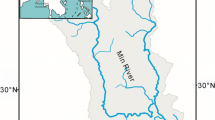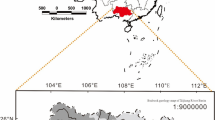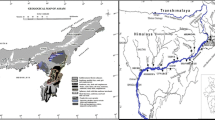Abstract
Chemical weathering in the Himalayan river basins is among the highest in the world and has received vast research attention related to past climate change. Many early estimates of chemical weathering are based on a small number of water property data that ignore those spatial and seasonal variations. Therefore, this study analyzed spatial and seasonal variations in chemical weathering in the Mekong Basin, where the geology, climate, and hydrologic cycle of the basin vary significantly from the lower to upper reaches and from dry to rainy seasons. We separately estimated the origins of dissolved elements and potential CO2 consumption rates using the numerous chemical compositions of river water throughout the entire basin and in both seasons. The CO2 consumption rate in the rainy season is three to five times that in the dry season that may be due to the high temperature and precipitation. Despite the low temperatures and dryness of the upper and middle basins, the CO2 consumption rate is approximately twice that in the lower reaches; this can be attributed to active physical denudation in steep mountainous areas which increases the surface area for water–rock interactions. The total CO2 consumption obtained by combining each season and basin was 48‒70 × 109 mol/a and 148‒159 × 109 mol/a for silicate and carbonate weathering, respectively, which are almost half the values of previous estimates. Our results suggest that seasonally and spatially separated evaluations are important for generating estimates of chemical weathering in large Himalayan rivers.







Similar content being viewed by others
References
Amiotte Suchet P, Probst J-L, Ludwig W (2003) Worldwide distribution of continental rock lithology: implications for the atmospheric/soil CO2 uptake by continental weathering and alkalinity river transport to the oceans. Global Biogeochem Cycles 17(2):1038. https://doi.org/10.1029/2002gb001891
Bastia F, Equeenuddin S (2019) Chemical weathering and associated CO2 consumption in the Mahanadi river basin, India. J Asian Earth Sci 174:218–231. https://doi.org/10.1016/j.jseaes.2018.12.010
Berner RA (2003) The long-term carbon cycle, fossil fuels and atmospheric composition. Nature 426:323–326. https://doi.org/10.1038/nature02131
Berner RA, Lasaga AC, Garrels RM (1983) The carbonate-silicate geochemical cycle and its effect on atmospheric carbon dioxide over the past 100 million years. Am J Sci 283:641–683
Bickle MJ, Chapman HJ, Tipper E et al (2018) Chemical weathering outputs from the flood plain of the Ganga. Geochim Cosmochim Acta 225:146–175. https://doi.org/10.1016/j.gca.2018.01.003
Brady PV, Carroll SA (1994) Direct effects of CO2 and temperature on silicate weathering: possible implications for climate control. Geochim Cosmochim Acta 58:1853–1856
Cheng G, Jin H (2013) Permafrost and groundwater on the Qinghai-Tibet plateau and in northeast China. Hydrogeol J 21:5–23. https://doi.org/10.1007/s10040-012-0927-2
Chetelat B, Liu CQ, Zhao ZQ et al (2008) Geochemistry of the dissolved load of the Changjiang Basin rivers: Anthropogenic impacts and chemical weathering. Geochim Cosmochim Acta 72:4254–4277. https://doi.org/10.1016/j.gca.2008.06.013
Dalai TK, Krishnaswami S, Sarin MM (2002) Major ion chemistry in the headwaters of the Yamuna river system. Geochim Cosmochim Acta 66:3397–3416. https://doi.org/10.1016/s0016-7037(02)00937-7
El Tabakh M, Utha-Aroon C, Schreiber BC (1999) Sedimentology of the cretaceous Maha Sarakham evaporites in the Khorat Plateau of northeastern Thailand. Sediment Geol 123:31–62. https://doi.org/10.1016/S0037-0738(98)00083-9
Feng QL (2002) Stratigraphy of volcanic rocks in the Changning-Menglian Belt in southwestern Yunnan, China. J Asian Earth Sci 20:657–664. https://doi.org/10.1016/S1367-9120(02)00006-8
Gaillardet J, Dupre B, Louvat P, Allegre CJ (1999) Global silicate weathering and CO2 consumption rates deduced from the chemistry of large rivers. Chem Geol 159:3–30. https://doi.org/10.1016/S0009-2541(99)00031-5
Galy A, France-lanord C (1999) Weathering processes in the Ganges-Brahmaputra basin and the riverine alkalinity budget. Chem Geol 159:31–60
Gupta A (2009) Geology and landforms of the Mekong Basin. The Mekong 3:29–51. https://doi.org/10.1016/B978-0-12-374026-7.00003-6
Han G, Tang Y, Xu Z (2010) Fluvial geochemistry of rivers draining karst terrain in Southwest China. J Asian Earth Sci 38:65–75. https://doi.org/10.1016/j.jseaes.2009.12.016
Hodges K (2006) Climate and the evolution of mountains. Sci Am 295:72–79
Huh Y, Edmond JM (1999) The fluvial geochemistry of the rivers of Eastern Siberia: III. Tributaries of the Lena nabar draining the basement terrain of the Siberian Craton and the Trans-Baikal highlands. Geochim Cosmochim Acta 63:967–987. https://doi.org/10.1016/S0016-7037(99)00045-9
Iida T, Inkhamseng S, Yodhida K, Ito S (2007) Seasonal variation in nitrogen and phosphorus concentrations in the Mekong River at Vientiane. J Jpn Soc Hydrol Water Resour 20:226–234. https://doi.org/10.3178/jjshwr.20.226
Li G, Hartmann J, Derry LA et al (2016) Temperature dependence of basalt weathering. Earth Planet Sci Lett 443:59–69. https://doi.org/10.1016/j.epsl.2016.03.015
Li J-Y, Zhang J (2005) Chemical weathering process and atmospheric CO2 consumption of Huanghe river and Changjiang river basins. Chin Geogr Sci 15:16–21
Li S, Lu XX, Bush RT (2014) Chemical weathering and CO2 consumption in the Lower Mekong River. Sci Total Environ 472:162–177. https://doi.org/10.1016/j.scitotenv.2013.11.027
Li S, Xu Z, Wang H et al (2009) Geochemistry of the upper Han River basin, China. 3: anthropogenic inputs and chemical weathering to the dissolved load. Chem Geol 264:89–95. https://doi.org/10.1016/j.chemgeo.2009.02.021
Liu C, He Y, Des Walling E, Wang J (2013) Changes in the sediment load of the Lancang-Mekong River over the period 1965–2003. Sci China Technol Sci 56:843–852. https://doi.org/10.1007/s11431-013-5162-0
Ma N, Szilagyi J, Niu GY et al (2016) Evaporation variability of Nam Co Lake in the Tibetan Plateau and its role in recent rapid lake expansion. J Hydrol 537:27–35. https://doi.org/10.1016/j.jhydrol.2016.03.030
Manaka T, Araoka D, Yoshimura T et al (2017) Downstream and seasonal changes of lithium isotope ratios in the Ganges-Brahmaputra river system. Geochem Geophys Geosyst 18:3003–3015. https://doi.org/10.1002/2016GC006738
Manaka T, Otani S, Inamura A et al (2015a) Chemical weathering and long-term CO2 consumption in the Ayeyarwady and Mekong river basins in the Himalayas. J Geophys Res Biogeosci. https://doi.org/10.1002/2015JG002932
Manaka T, Ushie H, Araoka D et al (2015b) Spatial and seasonal variation in surface water pCO2 in the Ganges, Brahmaputra, and Meghna Rivers on the Indian subcontinent. Aquat Geochem 21:437–458. https://doi.org/10.1007/s10498-015-9262-2
Mekong River Commission (2005) Overview of the hydrology of the Mekong Basin. Mekong River Commission, Vientiane
Mekong River Commission (2016) Annual report 2016 version 2.0. Mekong River Commission, Vientiane
Meybeck M, Ragu A (1997) River discharges to the oceans: an assessment of suspended solids, major ions and nutrients. Laboratoire de Géologie Appliquée, Université Pierre et Marie Curie, Paris
Meybeck M, Ragu A (2012) GEMS-GLORI world river discharge database. Laboratoire de Géologie Appliquée, Université Pierre et Marie Curie, Paris
Millero FJ (1979) The thermodynamics of the carbonate system in seawater. Geochim Cosmochim Acta 43(11–12):1651–1661. https://doi.org/10.1016/0016-7037(79)90184-4
Millot R, Gaillardet J, Dupré B, Allègre CJ (2002) The global control of silicate weathering rates and the coupling with physical erosion: new insights from rivers of the Canadian Shield. Earth Planet Sci Lett 196:83–98. https://doi.org/10.1016/S0012-821X(01)00599-4
Moon S, Huh Y, Qin J, van Pho N (2007) Chemical weathering in the Hong (Red) River basin: rates of silicate weathering and their controlling factors. Geochim Cosmochim Acta 71:1411–1430. https://doi.org/10.1016/j.gca.2006.12.004
Négrel P, Allègre CJ, Dupré B, Lewin E (1993) Erosion sources determined by inversion of major and trace element ratios and strontium isotopic ratios in river: the Congo Basin case. Earth Planet Sci Lett 120:59–76. https://doi.org/10.1016/0012-821X(93)90023-3
Noh H, Huh Y, Qin J, Ellis A (2009) Chemical weathering in the three rivers region of Eastern Tibet. Geochim Cosmochim Acta 73:1857–1877. https://doi.org/10.1016/j.gca.2009.01.005
Oeurng C, Cochrane TA, Arias ME et al (2016) Assessment of changes in riverine nitrate in the Sesan, Srepok and Sekong tributaries of the Lower Mekong River Basin. J Hydrol Reg Stud 8:95–111. https://doi.org/10.1016/j.ejrh.2016.07.004
Pokhrel Y, Burbano M, Roush J et al (2018) A review of the integrated effects of changing climate, land use, and dams on Mekong river hydrology. Water (Switzerland) 10:1–25. https://doi.org/10.3390/w10030266
Rai SK, Singh SK (2007) Temporal variation in Sr and 87Sr/86Sr of the Brahmaputra: implications for annual fluxes and tracking flash floods through chemical and isotope composition. Geochem Geophys Geosyst 8:1–14. https://doi.org/10.1029/2007GC001610
Raymo ME, Ruddiman WF (1992) Tectonic forcing of late Cenozoic climate. Nature 359:117–122
Riebe CS, Kirchner JW, Finkel RC (2004) Erosional and climatic effects on long-term chemical weathering rates in granitic landscapes spanning diverse climate regimes. Earth Planet Sci Lett 224:547–562. https://doi.org/10.1016/j.epsl.2004.05.019
Robbins LL, Hansen ME, Kleypas JA, Meylan SC (2010) CO2calc: a user-friendly seawater carbon calculator for Windows, Mac OS X and iOS (iPhone), U.S. Geol Surv. Open File Rep, 2010–1280.
Roy S, Gaillardet J, Allègre CJ (1999) Geochemistry of dissolved and suspended loads of the Seine river, France: anthropogenic impact, carbonate and silicate weathering. Geochim Cosmochim Acta 63:1277–1292. https://doi.org/10.1016/S0016-7037(99)00099-X
Samanta A, Tripathy GR, Das R (2019) Temporal variations in water chemistry of the (lower) Brahmaputra river: implications to seasonality in mineral weathering. Geochem Geophys Geosyst 20:2769–2785. https://doi.org/10.1029/2018GC008047
Singh S, Sarin MM, France-Lanord C (2005) Chemical erosion in the eastern Himalaya: major ion composition of the Brahmaputra and δ13C of dissolved inorganic carbon. Geochim Cosmochim Acta 69:3573–3588. https://doi.org/10.1016/j.gca.2005.02.033
Singh SK, Rai SK, Krishnaswami S (2008) Sr and Nd isotopes in River sediments from the Ganga basin: sediment provenance and spatial variability in physical erosion. J Geophys Res 113:1–18. https://doi.org/10.1029/2007JF000909
Tipper ET, Bickle MJ, Galy A et al (2006) The short term climatic sensitivity of carbonate and silicate weathering fluxes: insight from seasonal variations in river chemistry. Geochim Cosmochim Acta 70:2737–2754. https://doi.org/10.1016/j.gca.2006.03.005
Tran TV, Tran DX, Myint SW et al (2019) Examining spatiotemporal salinity dynamics in the Mekong River Delta using Landsat time series imagery and a spatial regression approach. Sci Total Environ 687:1087–1097. https://doi.org/10.1016/j.scitotenv.2019.06.056
Wang E, Burchfiel BC (2000) Late Cenozoic to Holocene deformation in southwestern Sichuan and adjacent Yunnan, China, and its role in formation of the southeastern part of the Tibetan Plateau. Geol Soc Am Bull 112:413–423. https://doi.org/10.1130/0016-7606(2000)112%3C413:LCTHDI%3E2.0.CO;2
Wang L, Zhang L, Cai W et al (2016) Consumption of atmospheric CO2 via chemical weathering in the Yellow River basin: the Qinghai-Tibet Plateau is the main contributor to the high dissolved inorganic carbon in the Yellow River. Chem Geol 430:34–44. https://doi.org/10.1016/j.chemgeo.2016.03.018
Wen R, Xiao J, Chang Z et al (2010) Holocene climate changes in the mid-high-latitude-monsoon margin reflected by the pollen record from Hulun Lake, northeastern Inner Mongolia. Quat Res 73:293–303. https://doi.org/10.1016/j.yqres.2009.10.006
West AJ, Galy A, Bickle M (2005) Tectonic and climatic controls on silicate weathering. Earth Planet Sci Lett 235:211–228. https://doi.org/10.1016/j.epsl.2005.03.020
White AF, Blum AE (1995) Effects of climate on chemical, weathering in watersheds. Geochim Cosmochim Acta 59:1729–1747
Wu W, Xu S, Yang J, Yin H (2008a) Silicate weathering and CO2 consumption deduced from the seven Chinese rivers originating in the Qinghai-Tibet Plateau. Chem Geol 249:307–320. https://doi.org/10.1016/j.chemgeo.2008.01.025
Wu W, Yang J, Xu S, Yin H (2008b) Geochemistry of the headwaters of the Yangtze River, Tongtian He and Jinsha Jiang: silicate weathering and CO2 consumption. Appl Geochem 23:3712–3727. https://doi.org/10.1016/j.apgeochem.2008.09.005
Xiaochi J, Yizhao W, Guanglian X (2003) Devonian to Triassic Successions of the Changning-Menglian Belt, Western Yunnan, China. Acta Geol Sin 77:440–456. https://doi.org/10.1111/j.1755-6724.2003.tb00125.x
Xu Z, Liu CQ (2007) Chemical weathering in the upper reaches of Xijiang River draining the Yunnan-Guizhou Plateau, Southwest China. Chem Geol 239:83–95. https://doi.org/10.1016/j.chemgeo.2006.12.008
Xu Z, Liu CQ (2010) Water geochemistry of the Xijiang basin rivers, South China: chemical weathering and CO2 consumption. Appl Geochem 25:1603–1614. https://doi.org/10.1016/j.apgeochem.2010.08.012
Yin A, Harrison TM (2000) Geologic evolution of the Himalayan-Tibetan orogen. Annu Rev Earth Planet Sci 28:211–280. https://doi.org/10.1080/01947641003598252
Yu Z, Wu G, Keys L et al (2019) Seasonal variation of chemical weathering and its controlling factors in two alpine catchments, Nam Co basin, central Tibetan Plateau. J Hydrol 576:381–395. https://doi.org/10.1016/j.jhydrol.2019.06.042
Zhang DD, Peart M, Jim CY et al (2003) Precipitation chemistry of Lhasa and other remote towns. Tibet Atmos Environ 37:231–240. https://doi.org/10.1016/S1352-2310(02)00835-X
Zhang X, Ren Y, Yin ZY et al (2009) Spatial and temporal variation patterns of reference evapotranspiration across the Qinghai-Tibetan Plateau during 1971–2004. J Geophys Res Atmos 114:1–14. https://doi.org/10.1029/2009JD011753
Zhong J, Li S, Tao F et al (2017) Impacts of hydrologic variations on chemical weathering and solute sources in the Min River basin, Himalayan-Tibetan region. Environ Sci Pollut Res 24:19126–19137. https://doi.org/10.1007/s11356-017-9584-2
Acknowledgements
We would like to thank students and researchers at Yunnan University for their great help in the fieldwork. We also thank for valuable suggestions that helped to improve this manuscript by Editor Dr. Marc Benedetti and anonymous reviewers. This research was partly supported by the Graduate Research Abroad in Science Program (GRASP) of the University of Tokyo for H. Kajita. It was also jointly supported by the Second Tibetan Plateau Scientific Expedition and Research (STEP) (2019QZKK0704), the Strategic Priority Research Program of Chinese Academy of Sciences (XDB26020301), and National Natural Science Foundation of China (NSFC) (U1902208, 41991323) to H. Zheng.
Author information
Authors and Affiliations
Contributions
HK and HK contributed to the study conception and design. Sample collection in the upper reaches was performed by HK and ZO. Sample collection in the middle and lower reaches was performed by HK, HK, YO, DA, SI, TY, and AS. On-site management during fieldwork was performed by KW, QY, HZ, and EU. Laboratory analyses were conducted by HK, YO, TY, and AI. The first draft of the manuscript was written by HK. All authors read and approved the final manuscript.
Corresponding author
Ethics declarations
Conflict of interest
The authors declare that they have no conflict of interest.
Additional information
Publisher's Note
Springer Nature remains neutral with regard to jurisdictional claims in published maps and institutional affiliations.
Electronic supplementary material
Below is the link to the electronic supplementary material.
Rights and permissions
About this article
Cite this article
Kajita, H., Ota, Y., Yoshimura, T. et al. Seasonal and Spatial Variations of Chemical Weathering in the Mekong Basin: From the Headwaters to the Lower Reaches. Aquat Geochem 26, 137–159 (2020). https://doi.org/10.1007/s10498-020-09374-y
Received:
Accepted:
Published:
Issue Date:
DOI: https://doi.org/10.1007/s10498-020-09374-y




